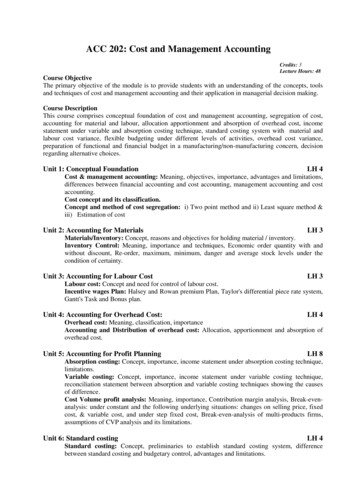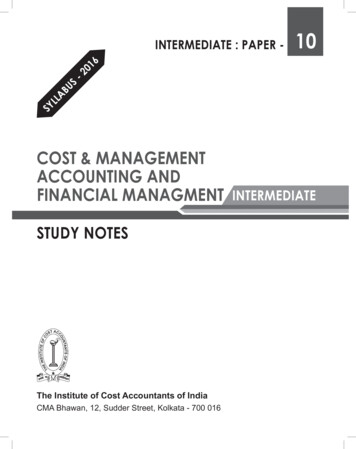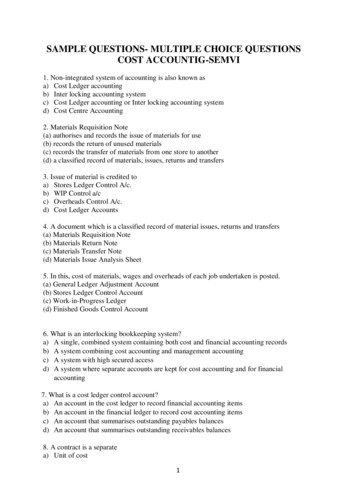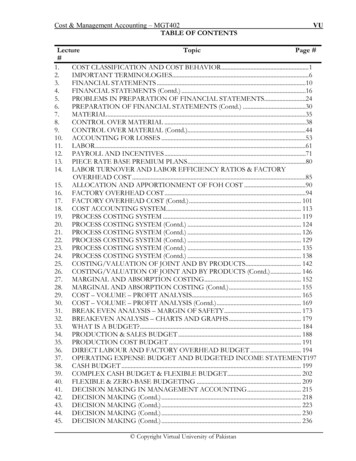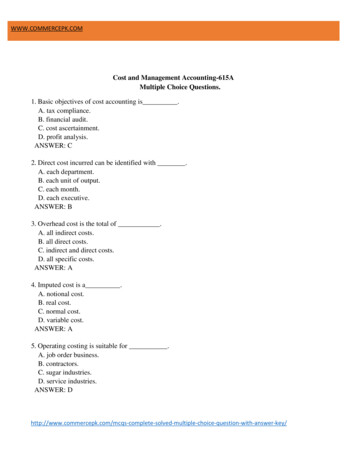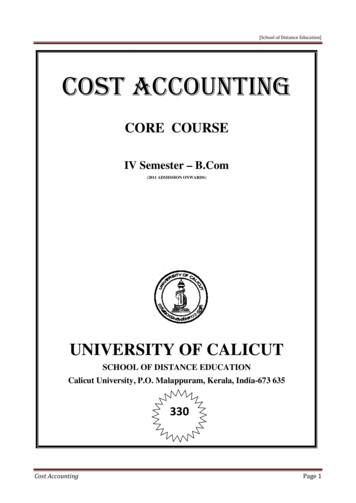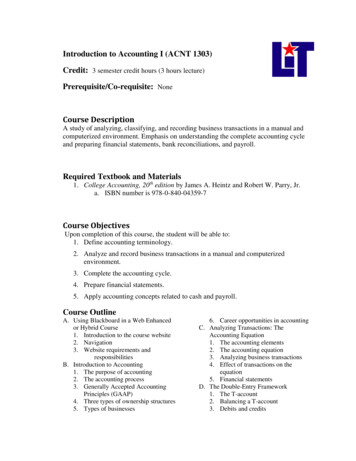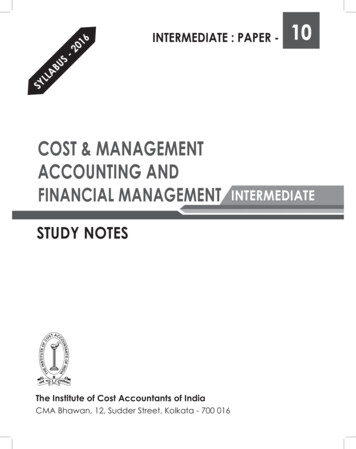
Transcription
60110SYLLABUS-2INTERMEDIATE : PAPER -COST & MANAGEMENTACCOUNTING ANDFINANCIAL MANAGEMENTSTUDY NOTESThe Institute of Cost Accountants of IndiaCMA Bhawan, 12, Sudder Street, Kolkata - 700 016INTERMEDIATE
First Edition : August 2016Reprint : September 2017Reprint : January 2018Reprint : June 2018Reprint : January 2019Edition : August 2019Published by :Directorate of StudiesThe Institute of Cost Accountants of India (ICAI)CMA Bhawan, 12, Sudder Street, Kolkata - 700 016www.icmai.inPrinted at :M/s. Sap Prints Solutions Pvt. Ltd.28A, Lakshmi Industrial EstateS. N. Path, Lower Parel (W)Mumbai - 400 013, MaharashtraCopyright of these Study Notes is reserved by the Institute of CostAccountants of India and prior permission from the Institute is necessaryfor reproduction of the whole or any part thereof.
Syllabus - 2016PAPER 10: COST & MANAGEMENT ACCOUNTING AND FINANCIAL MANAGEMENTSyllabus StructureThe syllabus comprises the following topics and study weightage:ACost & Management Accounting50%BFinancial Management50%ASSESSMENT STRATEGYThere will be written examination paper of three hours.OBJECTIVETo rovide an in depth knowledge of the detailed procedures and documentation involved in cost ascertainment systems.To understand the concepts of Financial Management and its application for managerial decision making.Learning AimsThe syllabus aims to test the student’s ability to: Understand the cost and management accounting techniques for evaluation, analysis and application in managerialdecision making; Compare and contrast marginal and absorption costing methods in respect of profit reporting; Apply marginal and absorption costing approaches in job, batch and process environments; Prepare and interpret budgets and standard costs and variance statements; Identify and apply the concepts of Financial ManagementSkill Set requiredLevel B: Requiring the skill levels of knowledge, comprehension, application and analysis.Note: Subjects related to applicable statutes shall be read with amendments made from time to time.Section A : Cost & Management Accounting1.Cost and Management Accounting - Introduction2.Decision Making Tools3.Budgeting and Budgetary Control50%4. Standard Costing and Variance Analysis5. Learning CurveSection B : Financial Management6. Introduction to Financial Management7. Tools for Financial Analysis and Planning8.Working Capital Management9.Cost of Capital, Capital Structure Theories, Dividend Decisions and Leverage Analysis10. Capital Budgeting - Investment Decisions50%
SECTION A: COST & MANAGEMENT ACCOUNTING [50 MARKS]1.Cost and Management Accounting:Introduction to Management Accounting - Relationship between Management Accounting and CostAccounting2.Decision Making Tools:(a) Marginal Costing: Break Even Analysis and Cost - volume - profit analysis; break-even charts and profitcharts; differential cost analysis; stock valuation under marginal costing vs. absorption costing; applicationsof marginal costing in decision making.(b)3.4.Transfer Pricing - Determination of Inter-departmental or Inter-company Transfer PriceBudgeting and Budgetary Control:(a)Budgetary Control and Preparation of Functional and Master Budgeting.(b)Fixed, Variable, Semi-Variable Budgets(c)Zero Based Budgeting (ZBB)Standard Costing & Variance Analysis:Computation of variances for each of the elements of costs, Sales Variances, Investigation of variances Valuation of Stock under Standard Costing - Uniform Costing and inter-firm comparison.5.Learning Curve:Concept of Learning curve and its application.Section B: FINANCIAL MANAGEMENT [50 marks]6.Introduction to Financial Management:Meaning - Objectives - Scope of Financial Management sources of Finance - Introduction to Financial Markets.7.Tools for Financial Analysis and Planning:Financial Ratio Analysis - Funds Flow Analysis - Cash Flow Analysis.8.Wroking Capital ManagementWorking Capital Management - Financing of Working Capital9.Cost of Capital, Capital Structure Theories, Dividend Decisions and Leverage AnalysisMeaning of Cost of Capital - Computation of Cost of Capital - Capital Structure Theories and Dividend DecisionsTheories (Walters - MM - Gordon Models) - Leverage Analysis10.Capital Budgeting - Investment Decisions:Concept of Capital Budgeting - Non-Discounted and Discounted Cash Flow Method - Ranking of Projects.
ContentsSECTION A - COST & MANAGEMENT ACCOUNTINGStudy Note 1 : Cost & Management Accounting1.1Introduction11.2Management Accounting - Definition21.3Significance of Management Accounting21.4Role of Management Accounting in Management Process31.5Functions of Management Accounting41.6Limitations of Management Accounting51.7Relationship between Management Accounting and Cost Accounting6Study Note 2 : Decision Making Tools2.1Marginal Costing92.2Tools and Techniques of Marginal Costing112.3Differential Cost Analysis212.4Differences between Absorption Costing and Marginal Costing232.5Application of Marginal Costing in Decision Making232.6Transfer Pricing342.7Objectives of Inter Company Transfer Pricing352.8Methods of Transfer Pricing35Study Note 3 : Budgeting and Budgetary Control3.1Budgetary Control and Preparation of Functional and Master Budgeting893.2Fixed, Variable, Semi-Variable Budgets933.3Zero Based Budgeting (ZBB)94Study Note 4 : Standard Costing and Variance Analysis4.1Introduction1114.2Computation of variances for each of the Elements of Costs, Sales Variances1134.3Investigation of variances & Reporting of Variances1264.4Valuation of Stock under Standard Costing1274.5Uniform Costing and Inter-Firm Comparison128
Study Note 5 : Learning Curve5.1Introduction1615.2Phases in Learning Curve1615.3Uses of Learning Curve1635.4Limitations to the usefulness of the Learning Curve1635.5Factors Affecting Learning Curve1645.6The Experience Curve1645.7Reasons for use of Learning Curve1655.8Application of Learning Curve166SECTION B - FINANCIAL MANAGEMENTStudy Note 6 : Introduction to Financial Management6.1Meaning1756.2Objectives1756.3Scope of Financial Management1776.4Sources of Finance1826.5Introduction to Financial Markets194Study Note 7 : Tools for Financial Analysis and Planning7.1Financial Ratio Analysis2057.2Funds Flow Analysis2297.3Cash Flow Analysis231Study Note 8 : Working Capital Management8.1Working Capital Management - Financing of Working Capital2658.2Inventory Management2858.3Management of Receivables2868.4Determinant of Credit Policy2888.5Cash Management295
Study Note 9 : Cost of Capital, Capital Structure Theories,Dividend Decisions and Leverage Analysis9.1Meaning of Cost of Capital - Computation of Cost of Capital3059.2Capital Structure Theories3199.3Dividend Policy3359.4Leverage Analysis3519.5EBIT - EPS Indifference Point / Level352Study Note 10 : Capital Budgeting - Investment Decisions10.1Capital Budgeting36710.2Need of Capital Budgeting Decision36710.3Significance of Capital Budgeting Decisions36810.4Process of Capital Budgeting36810.5Investment Criterion - Methods of Appraisal370
Section ACost & Management Accounting(Syllabus - 2016)
Cost and Management AccountingStudy Note - 1COST AND MANAGEMENT ACCOUNTINGThis Study Note includes:1.1Introduction1.2Management Accounting - Definition1.3Significance of Management Accounting1.4Role of Management Accounting in Management Process1.5Functions of Management Accounting1.6Limitations of Management Accounting1.7Relationship between Management Accounting and Cost Accounting1.1 INTRODUCTIONAccounting involves collection, recording, classification and presentation of financial data. The word ‘Accounting’ can be classified into three categories: (A) Financial Accounting (B) Management Accounting and (C) CostAccounting.Branches of AccountingFinancial AccountingManagement AccountingCost AccountingFINANCIAL ACCOUNTING:Financial Accounting has come into existence with the development of large-scale business in the form of jointstock companies. As public money is involved in share capital, Companies Act has provided a legal framework topresent the operating results and financial position of the company. Financial Accounting is concerned with thepreparation of Profit and Loss Account and Balance Sheet to disclose information to the shareholders. Financialaccounting is oriented towards the preparation of financial statements, which summarises the results of operationsfor select periods of time and show the financial position of the business on a particular date. Financial Accountingis concerned with providing information to the external users. Preparation of financial statements is a statutoryobligation. Financial Accounting is required to be prepared in accordance with Generally Accepted AccountingPrinciples and Practices. In fact, the corporate laws that govern the enterprises not only make it mandatory toprepare such accounts, but also lay down the format and information to be provided in such accounts. In sharpcontrast, management accounting is entirely optional and there is no standard format for preparation of thereports. Financial Accounts relate to the business as a whole, while management accounts focuses on parts orsegments of the business.CONCEPT OF MANAGEMENT ACCOUNTING:Management Accounting is a new approach to accounting. The term Management Accounting is composedof two words — Management and Accounting. It refers to Accounting for the Management. ManagementAccounting is a modern tool to management. Management Accounting provides the techniques for interpretationof accounting data. Here, accounting should serve the needs of management. Management is concerned withdecision-making. So, the role of management accounting is to facilitate the process of decision-making by themanagement. Managers in all types of organizations need information about business activities to plan, accurately,The Institute of Cost Accountants of India1
Cost and Management Accounting and Financial Managementfor the future and make decisions for achieving the goals of the enterprise. Uncertainty is the characteristic ofthe decision-making process. Uncertainty cannot be eliminated, altogether, but can be reduced. The functionof Management Accounting is to reduce the uncertainty and help the management in the decision makingprocess. Management accounting is that field of accounting, which deals with providing information includingfinancial accounting information to managers for their use in planning, decision-making, performance evaluation,control, management of costs and cost determination for financial reporting. Managerial accounting containsreports prepared to fulfil the needs of managements.1.2 MANAGEMENT ACCOUNTING - DEFINITIONDifferent authorities have provided different definitions for the term ‘Management Accounting’. Some of themare as under:“Management Accounting is concerned with accounting information, which is useful to the management”. —Robert N. Anthony“Management Accounting is concerned with the efficient management of a business through the presentation tomanagement of such information that will facilitate efficient planning and control”. —Brown and Howard“Any form of Accounting which enables a business to be conducted more efficiently can be regarded asManagement Accounting” —The Institute of Chartered Accountants of England and WalesThe Certified Institute of Management Accountants (CIMA) of UK defines the term ‘Management Accounting’ inthe following manner:“Management Accounting is an integral part of management concerned with identifying, presenting andinterpreting information for:1.Formulating strategy2.Planning and controlling activities3.Decision taking4.Optimizing the use of resources5.disclosure to shareholders and others, external to the entity6.disclosure to employees7.safeguarding assetsFrom the above definitions, it is clear that the management accounting is concerned with that accountinginformation, which is useful to the management. The accounting information is rearranged in such a mannerand provided to the top management for effective control to achieve the goals of business. Thus, managementaccounting is concerned with data collection from internal and external sources, analyzing, processing, interpretingand communicating information for use, within the organization, so that management can more effectively plan,make decisions and control operations. The information to be collected and analysed has been extended to itscompetitors in the industry. This provides more meaningful clues for proper decision-making in the right direction.The information in the management accounting system is used for three different purposes:1.Measurement2.Control and3.Decision-making1.3 SIGNIFICANCE OF MANAGEMENT ACCOUNTING1.3 SIGNIFICANCE OF MANAGEMENT ACCOUNTINGThe various advantages that accrue out of management accounting are enumerated below:(1)2Delegation of Authority: Now a day the function of management is no longer personal, managementaccounting helps the organisation in proper delegation of authority for the attainment of the vision andmission of the business.The Institute of Cost Accountants of India
Cost and Management Accounting(2)Need of the Management: Management Accounting plays the role in meeting the need of the management(3)Qualitative Information: Management Accounting accumulates the qualitative information so thatmanagement would concentrate on the actual issue to deliberate and attain the specific conclusion evenfor the complex problem.(4)Objective of the Business: Management Accounting provides measure and reports to the managementthereby facilitating in attainment of the objective of the business.1.4 ROLE OF MANAGEMENT ACCOUNTING IN MANAGEMENT PROCESSAn enterprise would operate, successfully, if it directs all its resources and efforts to accomplish its specifiedobjective in a planner manner, rather than reacting to events.Organisation has to be both efficient and effective. Organisation is effective when the planned objective isachieved. However, the firm is efficient only when the objective is achieved, with minimum cost and resources,both in physical and monetary terms. The role of Management Accounting is significant in making the firm bothefficient and effective. Management Accounting has brought out clear shift in the objective of accounting. Frommere recording of transactions, the emphasis is on analyzing and interpreting to help the management to securebetter results. In this way, Management Accounting eliminates intuition, which is not at all dependable, from thefield of business management to the cause and effect approach.It is well known the basic functions of management on-making and5.StaffingFunction of ManagementPlanningOrganisingControllingDecision MakingStaffingManagement accounting plays a vital role in the managerial functions performed by the managers.(1)Planning: Planning is the real beginning of any activity. Planning establishes the objectives of the firm anddecides the course of action to achieve it. It is concerned with formulating short-term and long-term plans toachieve a particular end. Planning is a statement of what should be done, how it should be done and whenit should be done. While planning, management accountant uses various techniques such as budgeting,standard costing, marginal costing etc for fixing targets. For example, if a firm determines to achieve aparticular level of profit, it has to plan how to reach the target. What products are to be sold and at whatprices? The Management Accountant develops the data that helps managers to identify more profitableproducts. What are the different ways to improve the existing profits by 25%? Management Accountingthrows various alternatives to achieve the goal.(2)Organising: Organising is a process of establishing the organizational framework and assigning responsibility topeople working in the organization for achieving business goals and objectives. The organizational structuremay not be the same in all organizations, some may have centralized, while others may be decentralizedstructures. The management accountant may prepare reports on product lines, based on which managerscan decide whether to add or eliminate a product line in the current product mix.The Institute of Cost Accountants of India3
Cost and Management Accounting and Financial Management(3)Controlling: Control is the process of monitoring, measuring, evaluating and correcting actual results toensure that a firm’s goals and plans are achieved. Control is achieved through the process of feedback.Feedback allows the managers to allow the operations continue as they are or take corrective action, bysome rearranging or correcting at midstream. The use of performance and control reports serve the functionof controlling. For example, a production supervisor may receive weekly or daily performance reports,comparing actual material cost with planed costs. Significant variances can be isolated for corrective action.In the normal course, periodical reports are submitted, appraising the performance against the targets set.Reports for action are given to the top management, following the principle of management by exception.Performance and control reports do not tell managers what to do. These feedback reports identify, whereattention is needed to help managers to determine the required course of action.(4)Decision-making: Decision-making is a process of choosing among competing alternatives. Decision-makingis inherent in all the above three functions of management-planning, organizing and controlling. There maybe different methods or objectives. The manager can plan or choose only one of the competing plans.Similarly, in organizing, decision can be made whether the organizational structure should be centralized ordecentralized. In control function, manager can decide whether variance is worthy to investigate or not.(5)Staffing: Staffing is the process of recruitment, selection, development, training, compensation andoverseeing employee in an organisation. Staffing, like all other managerial functions, is the duty which is veston the management to perform. The role of the management accounting in this regard is manning the entitystructure through proper and effective selection, appraisal, and development of the personnel to fill the roleassigned to the employer. Moreover, the management accountants have to reduce the labour turnoverand to control the overall employee cost.1.5 FUNCTIONS OF MANAGEMENT ACCOUNTINGThe primary objective of Management Accounting is to maximize profits or minimize losses. This is done through thepresentation of statements in such a way that the management is able to take corrective policy or decision. Themanner in which the Management Accountant satisfies the various needs of management is described as follows:(1)Storehouse of Reliable Data: Management wants reliable data for Planning, Forecasting and Decision-making.Management accounting collects the data from various sources and stores the information for appropriateuse, as and when needed. Though the main source of data is financial statements, Management Accountingis not restricted to the use of monetary data only. While preparing a sales budget, the managementaccountant uses the past data of the products sold from the financial records and makes projections basedon the consumer surveys, population figures and other reliable information to estimate the sales budget. So,management accounting uses qualitative information, unlike financial accounting, for preparing its reports,collecting and modifying the data for the specific purpose.(2)Modification and Presentation of Data: Data collected from financial statements and other sources is notreadily understandable to the management. The data is modified and presented to the management in sucha way that it is useful to the management. If sales data is required, it can be classified according to product,geographical area, season-wise, type of customers and time taken by them for making payments. Similarly,if production figures are needed, these can be classified according to product, quality, and time taken formanufacturing process. Management Accountant modifies the data according to the requirements of themanagement for each specific issue to be resolved.(3)Communication and Coordination: Targets are communicated to the different departments for theirachievement. Coordination among the different departments is essential for the success of the organisation.The targets and performances of different departments are communicated to the concerned departmentsto increase the efficiency of the various sections, thereby increasing the profitability of the firm. Varianceanalysis is an important tool to bring the necessary matters to the attention of the concerned to exercisecontrol and achieve the desired results.(4)Financial Analysis and Interpretation: Management accounting helps in strategic decision making. Topmanagerial executives may lack technical knowledge. For example, there are various alternatives to produce.There is always a choice for the sales mix. Management 344 Accounting for Managers Accountant givesfacts and figures about various policies and evaluates them in monetary terms. He interprets the data andgives his opinion about various alternative courses of action so that it becomes easier to the managementto take a decision.4The Institute of Cost Accountants of India
Cost and Management Accounting(5)Control: It is absolutely essential that there should be a system of monitoring the performance of alldivisions and departments so that deviations from the desired path are brought to light, without delayand are corrected then and there. This process is termed as control. The aim of this function ‘control’ is tofacilitate accomplishment of the goals in an efficient manner. For the discharge of this important function,management accounting provides meaningful information in a systematic and effective manner. However,the role of accountant is misunderstood. Many consider the accountant as a controller of their performance.Many accountants themselves misunderstand their own role as controllers. The real role of control is effectivecommunication and assists the managers in achieving their goals, as efficiently as possible.(6)Supplying Information to Various Levels of Management: Every level of management requires information fordecision-making and policy execution. Top-level management takes broad policy decisions, leaving dayto-day decisions to lower management for execution. Supply of right information, at proper time, increasesefficiency at all levels.(7)Reporting to Management: Reporting is an important function of management accounting to achieve thetargets. The reports are presented in the form of graphs, diagrams and other statistical techniques so as tomake them easily understandable. These reports may be monthly, quarterly, and half-yearly. These reportsare helpful in giving constant review of the working of the business.Storehouse of Reliable DataModification and Presentation of DataCommunication and CoordinationFinancial Analysis and InterpretationControlSupplying Information to Various Levels of ManagementReporting to Management1.6 LIMITATIONS OF MANAGEMENT ACCOUNTINGDespite the development of Management Accounting as an effective discipline to improve the managerialperformance, some of the limitations are as under:(1)Accuracy is not Ensured: Management Accounting is largely based on estimates. It does not deal withactual, alone, and thus total accuracy is not ensured under Management Accounting.(2)A Tool in the Hands of Management: Management Accounting is definitely a tool in the hands of management,but cannot replace management.(3)Strength and Weakness: Management Accounting derives information from Financial Accounting, CostAccounting and other records. The strength and weakness of these basic information providers become thestrength and weakness of Management Accounting too.(4)Costly Affair: The installation of Management Accounting is a costly affair so all the organizations, in particular,small firms cannot afford.The Institute of Cost Accountants of India5
Cost and Management Accounting and Financial Management(5)Lack of Knowledge and Understanding: The emergence of Management Accounting is the fusion of a numberof subjects like statistics, economics, engineering and management theory. Any inadequate grounding inany one or more of the subjects is bound to have an unfavourable effect on the consideration and solutionof the problems, relating to management performance.(6)Evolutionary Stage: Comparatively, Management Accounting is a new discipline and is still very much ina stage of evolution. Therefore, it comes across the same difficulties or obstacles, which a relatively newdiscipline has to face.(7)Psychological Resistance: Adoption of a system of Management Accounting brings about a radical changein the established pattern of the activity of the management personnel. It calls for rearrangement of personnelas well as their activities. This is bound to encounter opposition from some quarter or other.1.7 RELATIONSHIP BETWEEN MANAGEMENT ACCOUNTING AND COST ACCOUNTINGBETWEEN MANAGEMENT ACCOUNTING AND COST ACCOUNTING.7 R E L A T I O N S H I PRelationship between Management Accounting and Cost Accounting:Management Accounting is primarily concerned with the requirements of the management. It involves applicationof appropriate techniques and concepts, which help management in establishing a plan for reasonableeconomic objective. It helps in making rational decisions for accomplishment of management objectives. Anyworkable concept or techniques whether it is drawn from Cost Accounting, Financial Accounting, Economics,Mathematics and statistics, can be used in Management Accountancy. The data used in ManagementAccountancy should satisfy only one broad test. It should serve the purpose that it is intended for. A managementaccountant accumulates, summarises and analysis the available data and presents it in relation to specificproblems, decisions and day-to-day task of management. A management accountant reviews all the decisionsand analysis from management’s point of view to determine how these decisions and analysis contribute tooverall organisational objectives. A management accountant judges the relevance and adequacy of availabledata from management’s point of view.The scope of Management Accounting is broader than the scope of Cost Accountancy. In Cost Accounting,primary emphasis is on cost and it deals with its collection, analysis, relevance interpretation and presentation forvarious problems of management. Management Accountancy utilizes the principles and practices of FinancialAccounting and Cost Accounting in addition to other management techniques for efficient operations of acompany. It widely uses different techniques from various branches of knowledge like Statistics, Mathematics,Economics, Laws and Psychology to assist the management in its task of maximising profits or minimizing losses. Themain thrust in Management Accountancy is towards determining policy and formulating plans to achieve desiredobjective of management. Management Accountancy makes corporate planning and strategy effective.From the above discussion we may conclude that the Cost Accounting and Management Accounting areinterdependent, greatly related and inseparable.Self Learning Questions:1.Define management accounting and state its significance?2.Discuss the role of management accounting in management process.3.Describe the functions of management accounting.4.List down the limitation of management accounting.5.State the relationship between management accounting and cost accounting.6The Institute of Cost Accountants of India
Cost and Management AccountingMultiple Choice Questions:1.2.3.4.5.6.7.8.Planning and control are done byA.top managementB.lowest level of managementC.all levels of managementD.None of the aboveDecision-making concerns theA.PastB.FutureC.Past and future bothD.None of the aboveThe comparison of actual results with expected results is referred to asA.FeedbackB.ControllingC.NoneDecision-making is involved in the following function/s of managementA.PlanningB.OrganizingC.ControllingD.All the above functionsThis function works like a policeman to ensure the performance of the e of theseThe use of management accounting isA.CompulsoryB.OptionalC.Mandatory as per the lawD.None of the aboveManagement Accounting relates toA.Collection of data from different sourcesB.Modification of data to meet the specific needsC.Presentation of dataD.All of the aboveDivision of Accounting is divided intoA.2B.3C.4D.None of the above[Ans: 1. (a) 2. (b) 3. (a) 4. (d) 5 (a) 6. (b) 7. (d) 8. (b)]The Institute of Cost Accountants of India7
Cost and Management Accounting and Financial ManagementMatch the followings:Column AColumn B1Management Accounting is a tool to.A Effective and efficient2Management accounting is composed of.B3Organisation has to be bothC Maximisation of profit and minimisation of losses.4Objective of management AccountingD Management5Function of ManagementEPlanning, Organising, Controlling and DecisionmakingManagement and Accounting[Ans: D, E, A, C, B]True or False:1.Any form of accounting, which enables a business to be conducted more efficiently can be regarded asManagement Accounting.2.Standard formats are used in management accounting for preparation of reports.3.In Management Accounting, Generally Accepted Accounting Principles and Practices of Accountinggovern the preparation of reports.4.It is optional for a company to have financial accounting5.Management Accounting reports are public documents[Ans: 1. True, 2. False, 3. False, 4. False, 5. False]Fill in the blanks:1.Decision-making is a process of choosing among alternatives.2.Management Accounting tailor
(a) Marginal Costing: Break Even Analysis and Cost - volume - profit analysis; break-even charts and profit charts; differential cost analysis; stock valuation under marginal costing vs. absorption costing; applications of marginal costing in decision making.


